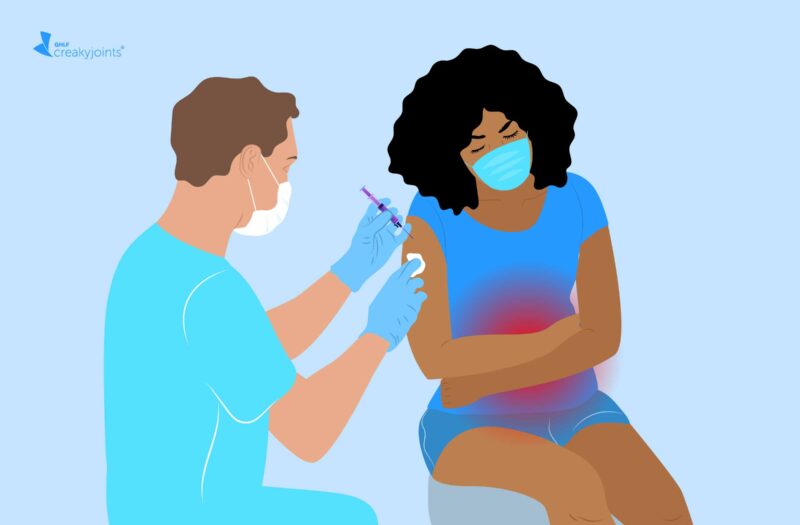Learn more about our FREE COVID-19 Patient Support Program for chronic illness patients and their loved ones..


If you’re immunocompromised, you know the breadth of calculations that comes with getting boosted for vaccines or medication.
Take the COVID-19 vaccine: First, you may need to get a three-dose primary series for an mRNA shot, rather than a standard two-dose series. Then, you need to follow it up with multiple boosters at the correct time intervals and perhaps schedule your medication around it. (Here’s everything you need to know about the fifth COVID-19 dose.)
Needless to say, it can start to feel complicated quickly. However, there may be a future in which vaccines release a bump in protection whenever you need it, without the need for an extra jab.
Researchers at the Massachusetts Institute of Technology (MIT) have developed microparticles that could one day create self-boosting vaccines, per a new study published in the journal Science Advances and funded by the Bill & Melinda Gates Foundation.
How the Microparticles Work
Think of these microparticles as coffee cups: They have lids that, when opened, can spill out coffee (or, in this case, drugs).
“We have a hole or cavity at the center of these particles that enables us to fill it with various therapeutic particles such as vaccines — but also other types of medications,” says Morteza Sarmadi, PhD, lead author of the study. “Basically, we end up with a storage cell that protects the therapeutic cargo at the center.”
The vaccine material is dried and combined with sugars and other stabilizers before being added to the cups. These mini “cups” are made with various polymers, or substances, that break down at different rates. You’ve probably already seen polymers like these used in other medical applications, like dissolvable stitches, per MDedge.
At a certain point, the lids would break and the vaccine within would be released. Scientists could determine the release time of the vaccine by the polymer they choose, since some materials take longer to break down than others. It could be days or months after the initial injection.
Researchers are still looking for ways to make the vaccine material more stable once it’s released, since the environment around the cups becomes more acidic as the particles open up (which could damage the often pH-sensitive drugs within). This will be an important part of preserving very sensitive vaccines.
How It Could Benefit the Immunocompromised
The original intent of this technology was to eliminate the need for multiple visits to health care providers in developing countries, where poor health care infrastructure can pose a challenge for adherence to multiple-dose vaccines. But having one-shot technology could benefit those in developed countries as well — particularly the immunocompromised or those living with chronic disease.
For instance, self-boosting vaccines could offer more protection to those who may not get high antibody responses from one dose of the COVID-19 vaccine. (More research is needed to determine how the timing of immunosuppressive medications like rituximab would work with these vaccines, says Sarmadi.)
But the benefits go beyond COVID-19: This technology could be used for a wide range of medications, which would save an immense amount of time and effort for those with chronic disease who require regular doses.
“In general, this is a platform technology, meaning it has a broad range of applications,” says Sarmadi. “A lot of chronic diseases need daily or weekly treatments, and we envision that this system can be really helpful and could make a daily treatment a monthly one, for example.” More research is needed to determine this type of application.
When Self-Boosting Vaccines Will Be Available
The research team plans to test self-boosting polio and hepatitis vaccines in animals with bodies similar to human bodies.
“The next step for this technology is to test these particles in large, non-human primates to make sure they are safe and advantageous,” says Sarmadi. “If this technology is successful, then there is a huge opportunity to move it into phase 1 clinical trials in humans, and then move on to phase 2 or phase 3.”
The researchers are also looking into the potential of self-boosting mRNA vaccines in smaller animal models.
When taking animal tests and clinical trials into consideration, technology like this is likely still about five to seven years from going to market, says Sarmadi. However, it provides an exciting glimpse of a future in which vaccines, cancer therapies, hormones, and biologics can be delivered in an efficient way that reduces trips to the doctor’s office — and ideally, increases adherence to and protection from prescribed drugs or vaccines.
Get Free Coronavirus Support for Chronic Illness Patients
Join the Global Healthy Living Foundation’s free COVID-19 Support Program for chronic illness patients and their families. We will be providing updated information, community support, and other resources tailored specifically to your health and safety. Join now.
Interview with Morteza Sarmadi, PhD, lead author of the study.
Sarmadi M, et al. Experimental and computational understanding of pulsatile release mechanism from biodegradable core-shell microparticles. Science Advances. July 13, 2022. doi: https://doi.org/10.1126/sciadv.abn5315.
‘Self-boosting’ vaccines could be immunizations of the future. MDedge. August 5, 2022. https://www.mdedge.com/infectiousdisease/article/256846/vaccines/self-boosting-vaccines-could-be-immunizations-future.





